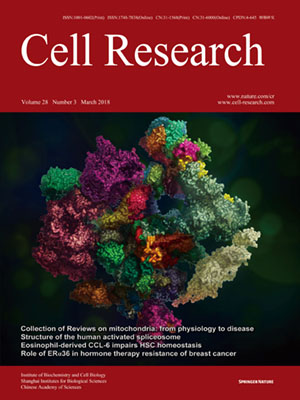
Volume 28, No 3, Mar 2018
ISSN: 1001-0602
EISSN: 1748-7838 2018
impact factor 17.848*
(Clarivate Analytics, 2019)
Volume 28 Issue 3, March 2018: 307-322
ORIGINAL ARTICLES
Structure of the human activated spliceosome in three conformational states
Xiaofeng Zhang1,*, Chuangye Yan1,*, Xiechao Zhan1,*, Lijia Li1, Jianlin Lei1,2, Yigong Shi1,3
1Beijing Advanced Innovation Center for Structural Biology, Tsinghua-Peking Joint Center for Life Sciences, School of Life Sciences and School of Medicine, Tsinghua University, Beijing 100084, China; 2Technology Center for Protein Sciences, Ministry of Education Key Laboratory of Protein Sciences, School of Life Sciences, Tsinghua University, Beijing 100084, China; 3Institute of Biology, Westlake Institute for Advanced Study, Westlake University, Shilongshan Road No. 18, Hangzhou, Zhejiang 310064, China
Correspondence: Yigong Shi, E-mail: shi-lab@tsinghua.edu.cn; Chuangye Yan,(yancy@mails.tsinghua.edu.cn)
During each cycle of pre-mRNA splicing, the pre-catalytic spliceosome (B complex) is converted into the activated spliceosome (Bact complex), which has a well-formed active site but cannot proceed to the branching reaction. Here, we present the cryo-EM structure of the human Bact complex in three distinct conformational states. The EM map allows atomic modeling of nearly all protein components of the U2 small nuclear ribonucleoprotein (snRNP), including three of the SF3a complex and seven of the SF3b complex. The structure of the human Bact complex contains 52 proteins, U2, U5, and U6 small nuclear RNA (snRNA), and a pre-mRNA. Three distinct conformations have been captured, representing the early, mature, and late states of the human Bact complex. These complexes differ in the orientation of the Switch loop of Prp8, the splicing factors RNF113A and NY-CO-10, and most components of the NineTeen complex (NTC) and the NTC-related complex. Analysis of these three complexes and comparison with the B and C complexes reveal an ordered flux of components in the B-to-Bact and the Bact-to-B* transitions, which ultimately prime the active site for the branching reaction.
10.1038/cr.2018.14
FULL TEXT | PDF
Browse 1175


